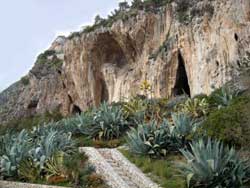The prehistoric period in Liguria
In Liguria the first hunters settled in the caves near the coast already in the lower Paleolithic. This is evidenced by the numerous human remains found in this area of which the oldest, discovered in the Vallonnet cave (now French), dates back to 900,000 years ago.
 A short distance away, in the Grotta del Principe ai Balzi Rossi , near Ventimiglia, an iliac bone of a woman dating back to 240,000 years ago was found, and also in this area there are traces of Neanderthal man in many coastal caves, but also at Sanremo, in the weapon of Taggia, near Savona (in the Toirano caves, for example) and near Finale Ligure where numerous tools, hunting tools and engravings from the life of our ancestors have been discovered.
A short distance away, in the Grotta del Principe ai Balzi Rossi , near Ventimiglia, an iliac bone of a woman dating back to 240,000 years ago was found, and also in this area there are traces of Neanderthal man in many coastal caves, but also at Sanremo, in the weapon of Taggia, near Savona (in the Toirano caves, for example) and near Finale Ligure where numerous tools, hunting tools and engravings from the life of our ancestors have been discovered.
In particular, in the Finale area there is the sumptuous burial of the Young Prince (Arene Candide cave), dating back to 21,000 years ago.
The castellari, fortified towns on the heights for defensive purposes, were born during the Copper, Bronze and Iron Ages. Considerable remains of castles are found near Savona , in Val Nervia and on Mount Bignone , above Sanremo, but also above Sestri Ponente , in Camogli and in the Spezzino; the network of fortifications, however, was vast and the term castellaro was used very often.The Ligurians were a people who during the Iron Age inhabited a very large area, from northern Italy to the Rhone valley to Catalonia and, the historian Hesiod , defined them among the oldest inhabitants of the world.
Where the Ligyes (later Ligures) came from, remains a mystery, it is certainly known that they traded economically and culturally with the Etruscans and with the Greek inhabitants of the coasts and numerous finds (even Mesopotamian) testify to this. Furthermore, there are no written documents and therefore it is assumed that they wrote and spoke in Greek or Etruscan. It is known that they called themselves Ambrones , which would suggest amber and consequently the Baltic, but there is no certainty about it.